
The Vanuatu rain forests are tropical and subtropical moist broadleaf forests ecoregion which includes the islands of Vanuatu, as well as the Santa Cruz Islands group of the neighboring Solomon Islands. It is part of the Australasian realm, which includes neighboring New Caledonia and the Solomon Islands, as well as Australia, New Guinea, and New Zealand.

The monarchs comprise a family of over 100 passerine birds which includes shrikebills, paradise flycatchers, and magpie-larks.

The yellow-rumped thornbill is a species of passerine bird from the genus Acanthiza. The genus was once placed in the family Pardalotidae but that family was split and it is now in the family Acanthizidae. There are four subspecies of yellow-rumped thornbill. It is a small, brownish bird with a distinctive yellow rump and thin dark bill. It inhabits savannah, scrub and forests across most of Australia and eats insects. The species engages in cooperative breeding.
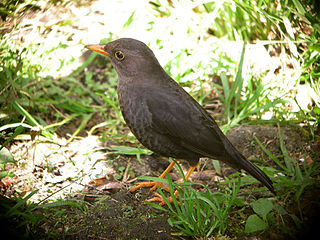
The island thrush is a common forest bird in the thrush family. Almost 50 subspecies have been described, ranging from South East Asia and Melanesia, to Samoa, exhibiting great differences in plumage. Several subspecies are threatened and three have already become extinct.

The New Zealand fernbird or simply fernbird is an insectivorous bird endemic to New Zealand. In the Māori language, it is named kōtātā or mātātā.

The nightingale reed warbler, or Guam reed-warbler, was a songbird endemic to Guam. It has not been seen since 1969.

The rusty-winged starling is a species of starling in the family Sturnidae. It is found in the Santa Cruz Islands and Vanuatu.

The paradise drongo or ribbon-tailed drongo is a species of bird in the family Dicruridae. It is endemic to New Ireland in the Bismarck Archipelago, Papua New Guinea. With a total length of 51 to 63 cm and body mass of 130 g (4.6 oz), this may be the largest species of drongo.

The White-breasted Robin is a passerine bird in the Australasian robin family Petroicidae and the Yellow Robin genus Eopsaltria. Occasionally it is placed in the genus Quoyornis. It is endemic to southwestern Australia. Unlike many other Australian robins, it lacks bright colours in its plumage, being a predominantly greyish bird with white underparts. Like other closely related Australasian robins, it is a cooperative breeder. It is sedentary, with pairs or small groups maintaining territories.

The slaty monarch is a species of bird in the family Monarchidae endemic to Fiji. Its natural habitat is subtropical or tropical moist lowland forests.
The Vanikoro monarch is a species of bird in the monarch family endemic to the Santa Cruz Islands. Its natural habitat is subtropical or tropical moist lowland forests and it is threatened by habitat loss. Alternate names for the Vanikoro monarch include slaty flycatcher, small slaty flycatcher, small slaty monarch and the Vanikoro flycatcher.

The hooded monarch is a species of bird in the family Monarchidae. It is found on New Guinea. Its natural habitat is subtropical or tropical moist lowland forests.

Myiagra is a genus of passerine birds in the family Monarchidae, the monarch flycatchers, native to Australasia, sometimes referred to as the broad-billed flycatchers or simply broadbills.

The azure-crested flycatcher or the blue-crested flycatcher, is a species of bird in the monarch flycatcher family Monarchidae. It is endemic to Fiji, where it is found on Taveuni.

The Melanesian flycatcher is a species of bird in the monarch-flycatcher family Monarchidae. The species is found on islands in Melanesia.
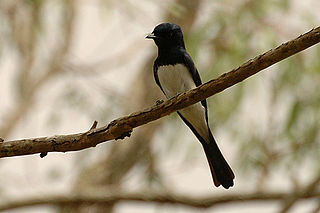
The satin flycatcher is a species of bird in the family Monarchidae. Males stand out with their blue-black feathers contrasting their white bellies, and the females with their bright orange throats. It breeds mostly in south-eastern Tasmania and Australia. It is declining throughout the eastern seaboard due to predation from the introduced Red Fox and habitat loss. It is a vagrant to New Zealand.
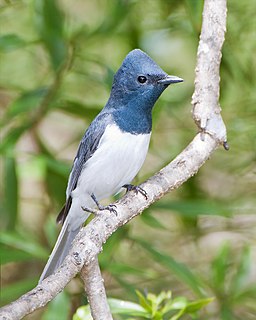
The leaden flycatcher is a species of passerine bird in the family Monarchidae. Around 15 cm (6 in) in length, the male is lustrous azure with white underparts, while the female possesses leaden head, mantle and back and rufous throat and breast. It is found in eastern and northern Australia, Indonesia, and Papua New Guinea. Its natural habitat is subtropical or tropical mangrove forests in the northern parts of its range, in the south and inland it is eucalypt woodland.
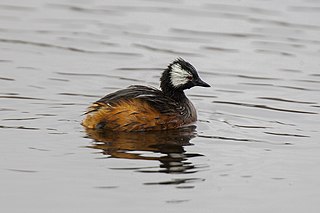
The white-tufted grebe, also known as Rolland's grebe, is a species of grebe in the family Podicipedidae. Found in the southern half of South America, its natural habitat is freshwater lakes, ponds and sluggish streams.
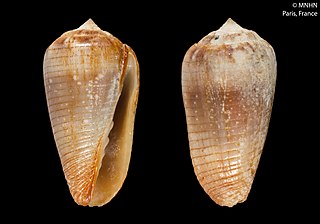
Imbricariopsis vanikorensis, common name the Vanikoro mitre, is a species of sea snail, a marine gastropod mollusk in the family Mitridae, the miters or miter snails.
The chestnut-throated flycatcher is a species of bird in the monarch-flycatcher family Monarchidae. The species is endemic to Fiji.




















